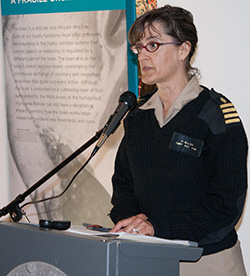Advancing vision care paramount for service members health
By Paul Bello, National Museum of Health and Medicine
SILVER SPRING, Md. - Military personnel endure numerous attacks that potentially impair their vision, whether from a direct blast, traumatic brain injury or environmental exposure. With May designated as Healthy Vision Month, the National Museum of Health and Medicine (NMHM) seized the opportunity to welcome U.S. Navy Capt. Penny Walter, executive director, Department of Defense (DoD) Vision Center of Excellence (VCE), to its monthly Medical Museum Science Café, May 26. Her discussion included certain types of eye injuries and the treatments being developed to repair vision for service members.
Walter has served in the optometry field since being commissioned as a lieutenant in 1989. She said casualties from present conflicts are leading to changes in healthcare needs, as well as changes in research and development. She estimates that approximately 29 percent of service members sustain some type of head or neck injury. When it comes to injuries from an improvised explosive device (IED), she said most require a collaboration between multiple specialties, such as plastic surgery, neurosurgery, facial reconstruction, physical therapy, and behavioral health.
"It's not unusual for patients who suffered a blast or multiple blasts to lose consciousness or have a traumatic brain injury (TBI). It's being called the signature injury of the current war," Walter said. "Visual consequences are also quite common and have symptoms such as loss of focusing near or far, the inability to concentrate, double-vision, photo phobia (a sensitivity to light) and visual field loss."
While vision itself can be good after a mild traumatic brain injury, Walter explained that visual processing is what's often impaired. Treatment can also be frustrating because not much can be done surgically or medically beyond prescribing glasses or providing supportive care. Because the role of vision therapy has not yet been proven or disproven, Walter noted there's significant interest in providing visual therapy to patients in DoD and Veteran Affairs (VA) healthcare systems.
"Since most of the patients remain on active duty, their treatment would remain within DoD facilities," Walter said. "Deactivated reservists would return home and seek therapy from VA administration or community healthcare systems."
Another group of patients exist in the middle, according to Walter. Those with a history of blast or concussive trauma, but without obvious gross ocular injuries. Many times vision impairment will not become evident until several months after the injury. These individuals may or may not have ocular syndromes, but will have significant demonstrable ocular damage, such as angle recession where the drainage angle of one's eye gets ripped. If that's damaged, the cornea will swell and everything will look blurry, Walter said.
The DoD is currently examining how blast waves affect the eyes. The organization is starting to put chips in helmets to help gauge the strength of a blast wave. Walter expects that these chips will lead to better treatment, but that much research is on the horizon before knowing more answers. (An example of one such modified helmet is on display at NMHM.
"Not long after our creation in 2008, the Vision Center for Excellence created a vision registry of data to help guide research, clinical education, to promote best practices and inform policy," Walter said. "The registry has come a long way in a short amount of time. It translates vision related data into manual information and empowers the vison care community to support vision care analysis."
Other education initiatives include the center's campaign "Shields Save Sight," which encourages service members to proactively wear eye protection, even when at home. According to Walter, almost half of all eye injuries occur around the home, most often during home improvement projects (44%) or recreational sports (14.7%), based on studies conducted by the VCE.
Inpatient and outpatient care stat sheets have also been created for patients who are blind or partially sighted. These sheets help remind staff what to do when someone comes in with this type of condition. Workshops on vision disorder are also conducted to keep providers technically competent.
"Assimilation is a proactive skill and we want people to remain fresh in that arena," Walter said. "Our mission is to enhance the quality of life for our service member and veterans." For more on the Department of Defense Vision Center of Excellence, visit http://vce.health.mil.
NMHM's Medical Museum Science Cafés are a regular series of informal talks that connect the mission of the Department of Defense museum with the public. NMHM was founded as the Army Medical Museum in 1862 and moved to its new location in Silver Spring, Maryland, in 2012.
The next science café is entitled "172 Orbits Around the Earth" and features former NASA astronaut Dr. Mary Cleave. It will be held Tuesday, June 23, from 6 -7 p.m. at NMHM. For more information, please call 301-319-3303 or visit www.medicalmuseum.mil.

|
Caption:
U.S. Navy Capt. Penny Walter, executive director, Department of Defense Vision Center for Excellence, discusses eye injuries and treatments to repair vision for service members at a monthly Medical Museum Science Café hosted by the National Museum of Health and Medicine May 26, 2015.
(National Museum of Health and Medicine photo by Paul Bello) |



